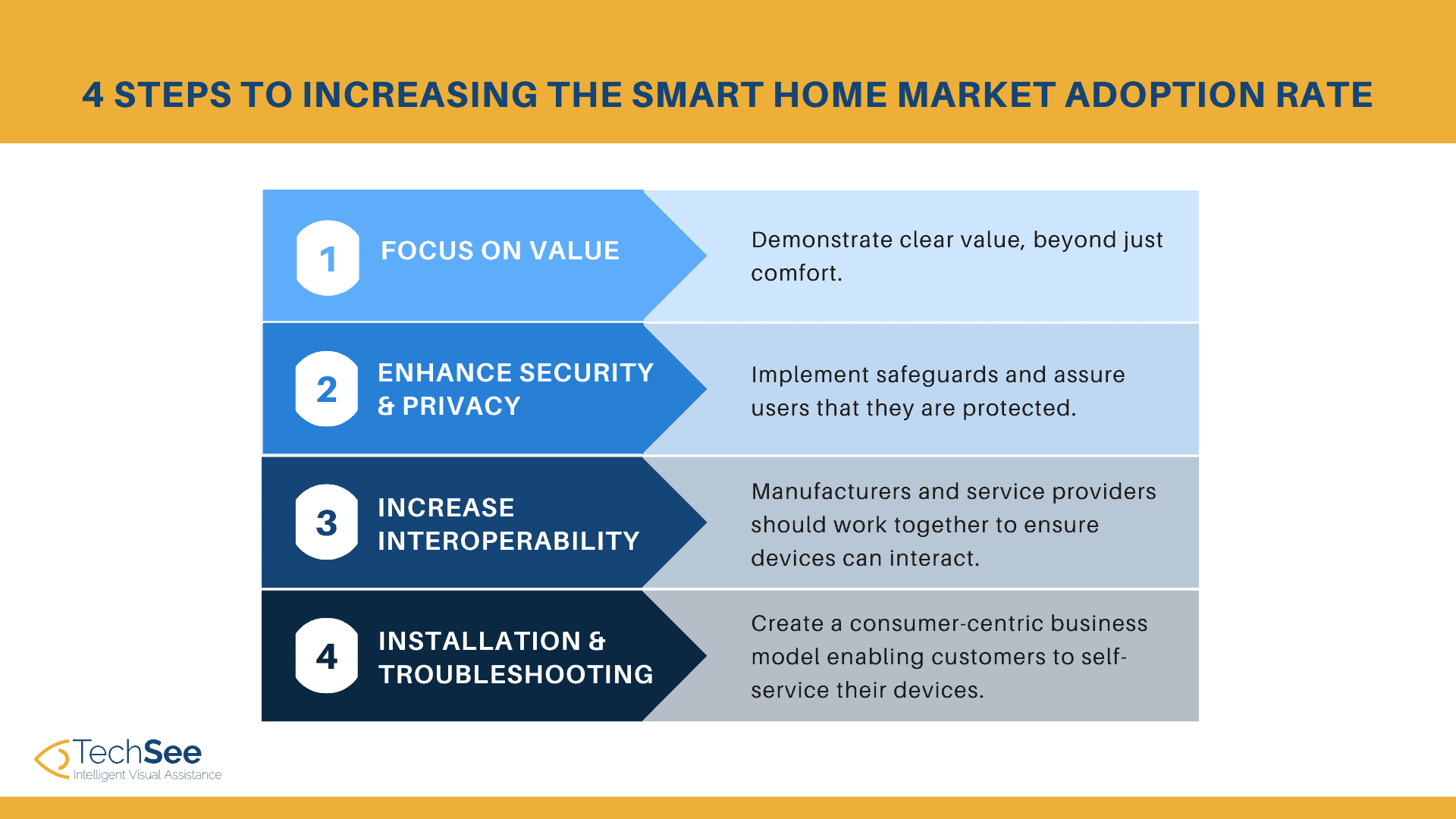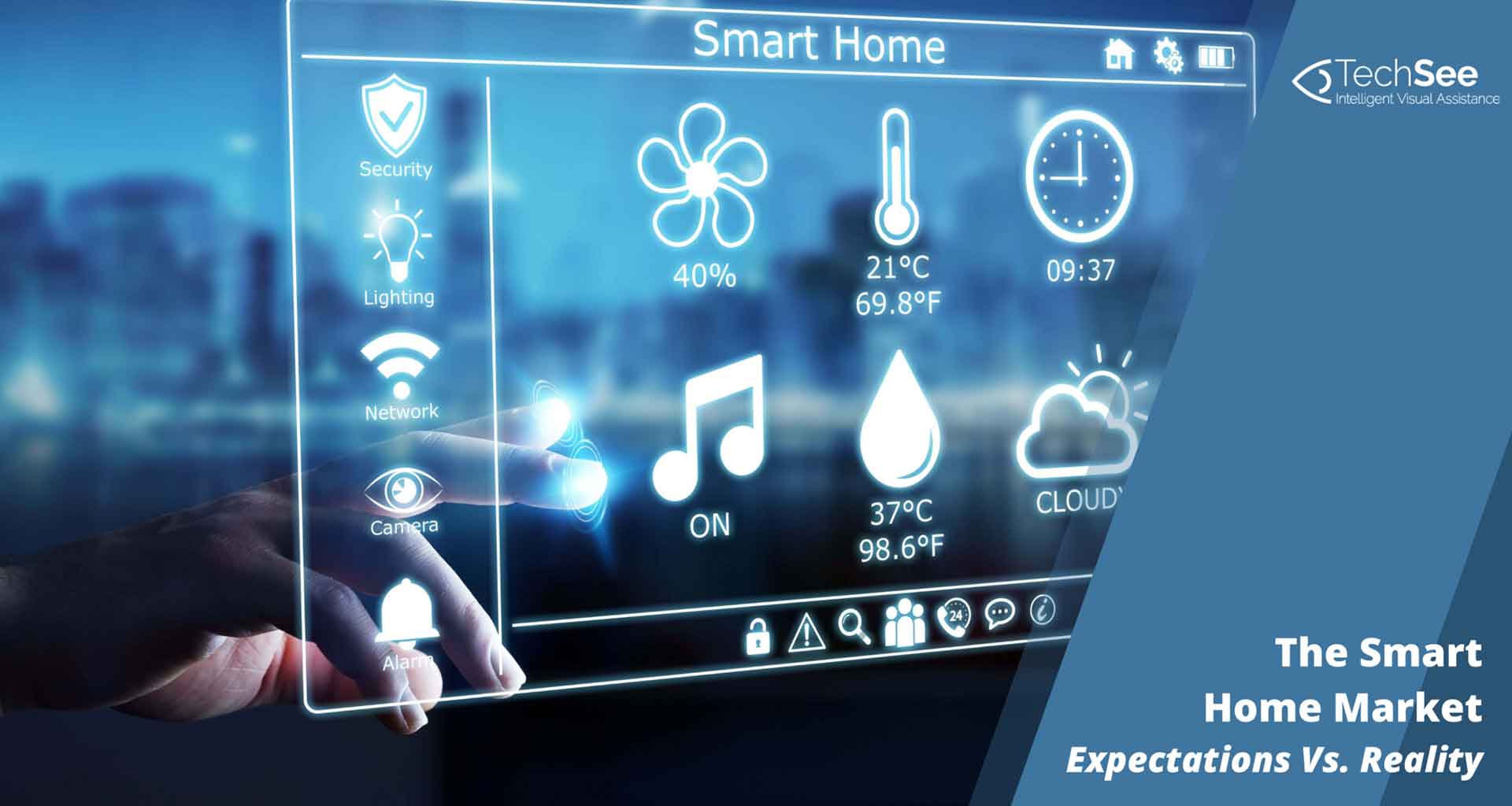Contents
- The Real Growth of the Smart Home Market
- Reasons for the Smart Home Market Slowdown
- Value: Is the Global Smart Home Market as Useful as Expected?
- Security & Privacy: A Smart Home Market Analysis Reveals Concerns
- Interoperability & Stability: Will a Universal Standard for the Smart Home Devices Market Help?
- Installation Maintenance & Troubleshooting: Can Modern Technology Boost Smart Home Market Growth?
- 4 Steps to Overcoming Obstacles to Smart Home Market Adoption
- How to Accelerate the Smart Home Market Growth
All eyes were on the smart home market in 2017. After all, industry experts predicted that the industry would be valued at $137.91B by 2023, growing at a CAGR of 13.61%. Tech giants were all clamoring to get in on the action with Google Home, Apple HomeKit, Amazon Echo and Samsung SmartThings creating buzz, and new smart devices flooding the market at a dizzying rate.
Questions about how smart home support works? Download this Report
The Real Growth of the Smart Home Market
However, despite these high expectations, the smart home adoption rate has been lower than anticipated. While the connected home market is growing steadily, it certainly has not exploded. In fact, according to smart home market research by the Consumer Technology Association (CTA), in 2021 the smart home devices market is predicted to experience flat revenues of $15 billion, with an 11% increase in unit sales.
What went wrong in the trajectory of the smart home market adoption, and why did so many experts miss the mark?

Reasons for the Smart Home Market Slowdown
There are a number of factors contributing to the smart homes technology statistics miscalculation, such as:
- value
- security and privacy
- interoperability and stability, and
- Installation maintenance and troubleshooting.
Value: Is the Global Smart Home Market as Useful as Expected?
In many cases the value of individual parts of the smart home is unclear. While some smart home devices may initially seem like the epitome of value and convenience, in practice many may not be as relevant or as helpful as anticipated.
The Bruno is a $140 trash can that features a built-in vacuum and will remind you to take out the trash when full. However, the product does not fully replace a vacuum. It rather simply acts as a high-tech dustpan, diminishing its value especially when compared to the price of a standard $20 trash can. In addition, it must be recharged every month and requires the use of proprietary trash bags. This brings its value into question even further.
While the Samsung Family Hub refrigerator can show you the inside of your fridge and help create and sync shopping lists, it comes with a $4K price tag. This has consumers considering whether auto-updates on groceries are really that critical.
Security & Privacy: A Smart Home Market Analysis Reveals Concerns
While many people choose to actively share their personal experiences over social media, they are wary of smart devices having access to personal data about their homes and habits. The fear of disclosing private information is a real obstacle to overcome, considering the level of access afforded to smart devices such as:
-
-
- connected security cameras
- motion sensors, and other
- home-based Virtual Assistants.
-
Imagine the sheer magnitude of information a home-based device like Alexa has stored, and the potential fallout if that data is breached. Similarly, hacking into a home’s connected security cameras can allow footage of an individual’s most private moments at home to enter the public domain.
With widespread privacy scandals in the news on a regular basis, such as the recent one at Facebook, the results of Data Grail’s smart home market analysis come as no surprise. More than 82% of survey participants expressed concern about businesses monitoring and collecting personal data from their smart devices, affecting smart home trends.
Interoperability & Stability: Will a Universal Standard for the Smart Home Devices Market Help?
Smart home products depend on protocols and standards to interact with each other, such as:
-
-
- Wi-Fi
- Bluetooth
- Z-Wave, and
- ZigBee.
-
The smart home market has not adopted a mainstream standard, which can make coordination between devices built for different platforms difficult.
In addition, while connecting appliances to the Internet can make a smart home run smoothly, when the supporting servers go down, so do the conveniences. As demonstrated when Amazon Web Services experienced a wide outage, smart devices that relied on network availability effectively became useless.
Outages result in dark homes when wireless light bulbs will not turn on, cold homes when smart thermostats cannot function, and quiet homes when entertainment systems cannot be operated. It’s therefore hardly surprising that the smart home adoption rate is so low.
Installation Maintenance & Troubleshooting: Can Modern Technology Boost Smart Home Market Growth?
Connected devices are perceived differently than the older consumer appliances or electronics. While an older model washing machine can operate with nary a repair for a decade, a connected machine must be regularly updated, maintained properly and connected to the right networks in order to deliver all of its smart functionalities.
This perception is in conflict with modern consumers’ aspirations to be able to self-manage their technology. In CSG’s infographic on consumer interest in AR support, 34% of respondents prefer self-service AR support with repairs of technology devices, rather than mailing an item to a store. Their smart home market research indicates that 45% of people are interested in AR based self-service when installing or repairing a technological device.
4 Steps to Overcoming Obstacles to Smart Home Market Adoption
When considering the smart home market analysis, the reasons for the slow adoption of smart home devices are readily apparent, as detailed above. This begs the question: what can be done to increase the smart home adoption rate?

Focus on Value
While the perception of innovation was able to carry the smart home market through the initial phase of the hype cycle, the next wave of adopters is expecting real value for their investment. Providers must ensure smart devices demonstrate clear value, beyond just comfort. Segments that have established clear value, such as dollar savings due to energy management or heightened safety due to smart security systems, have traditionally experienced higher rates of adoption.
For example, according to Grand View Research, the global smart lighting market was valued at 10.85 billion USD in 2020 and expected to reach 46.9 billion USD by 2028, at a CAGR of 20.4% from 2021-2028. The global smart security systems market reached 2.49 billion USD in 2020 and is forecast to grow to more than 5 billion USD by 2025. The consumer benefits of these segments of the global smart home market are clear and with the cost gap closing, demand is likely to further increase.
Enhance Cyber Security and Ensure Privacy
The connected home is vulnerable to cyber security threats: either via devices connected to the network or to the servers that gather, store, and analyze information from the sensors. An attacker may be able to for instance:
- contaminate a smart device with a virus
- hack into the wireless service
- manipulate any of the smart devices, and
- access personal data such as banking information.
This could lead to a number of worst case scenarios, including identity theft, or a home invasion if the house’s smart lock is breached.
Providers must take a two-fold stance to remove this barrier:
- Implement appropriate levels of controls to safeguard consumer data and protect the smart home ecosystem.
- Proactively address the relevant consumer concerns in order to assure users that they are well-protected.
Increase Interoperability and Stability
The lack of universal standards for the manufacture of IoT devices is one of the most important hurdles to clear before the smart home devices market can truly succeed. Device manufacturers and service providers should act together to create an environment where devices can interact with each other. Clear standards in terms of interoperability, security and data must be put in place for IoT to grow at its potential. Open source platforms and inter-industry collaboration will nurture innovation and ease the path to mass adoption.
Provide Installation Support and Troubleshooting
Providers must consider consumer sentiment when making decisions about product complexity, packaging, and other consumer-facing services. This will allow them to create a consumer centric business model that keeps the customer experience top of mind. In cases where consumers do need extra help in setting up devices, customer service must be easy to access and provide all the information needed.
Companies can provide interactive autonomous self-installation solutions such as augmented reality (AR) user guides or installation bots, etc. They could also partner with third-party providers to provide installation and troubleshooting services to customers. This should result in positive smart home market growth.
How to Accelerate the Smart Home Market Growth
Despite the initial popularity of smart homes and smart home technologies, their prevalence is not yet as widespread as anticipated, and thus their potential remains untapped. To increase the smart home market adoption rate, device manufacturers and service providers must be proactive and take steps such as:
- increasing the value and convenience of the smart home
- focusing on any security or privacy concerns
- addressing the interoperability and stability of smart devices, and
- developing clear processes for installation support and troubleshooting.
Then, further action can be taken to raise awareness and educate consumers about the relevance and practical benefits of the connected home. Smart home trends should in turn reflect this, with more consumers driven to adopt smart lifestyles.







